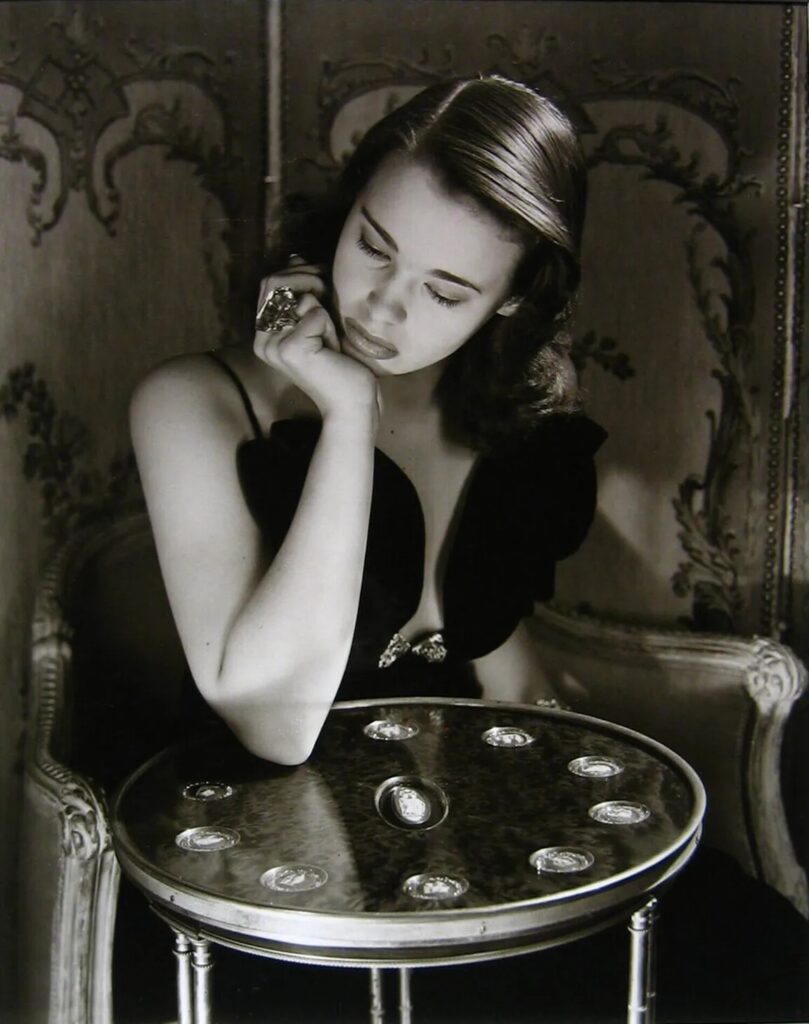Horst P. Horst
Horst P. Horst (1906–1999) was a pioneer of the genre now known as classic fashion photography. He produced elegant, sculptural images that made him one of the most influential fashion photographers of the mid-20th century. His work continues to resonate today for its striking use of light, composition, and timeless glamour.
Born Horst Paul Albert Bohrmann in Germany, Horst originally studied architecture and apprenticed with Le Corbusier in Paris. The tenets of architectural practice—precision, geometry, and spatial awareness—would later influence the construction of his photographic images. While in Paris, he shifted his focus to photography and apprenticed under George Hoyningen-Huene, a leading fashion photographer for Vogue. Their collaboration helped hone Horst’s technical precision and his aesthetic sense, resulting in portrait sessions that could last days as he sculpted the perfect balance of light and shadow.
By 1931, Horst was shooting for French Vogue, and the following year he began contributing to British Vogue, championed by art director Mehemed Agha. His work was imbued with the prevailing modernist and surrealist influences of the time, which he wove into fashion shoots featuring such luminaries as Coco Chanel, Greta Garbo, Joan Crawford, and Katharine Hepburn.
One of his most iconic images, Mainbocher Corset (1939), was created on the eve of his departure from Europe as the German army invaded France. The image—of a model’s back, partially undressed in a loosening corset—has become emblematic of beauty poised on the brink of collapse. That same year, Horst emigrated to the United States, where he became a citizen and formally adopted the name Horst P. Horst. Initially struggling to find work, he was eventually hired by American Vogue and soon immersed himself in the world of New York high society. Alongside his fashion photography, he created a celebrated body of portraits capturing the era’s cultural icons.
Horst published several books, including Photographs of a Decade (1945), Patterns from Nature (1946), and Salute to the Thirties (1971, with Hoyningen-Huene). His influence has extended to generations of photographers, including Irving Penn, Richard Avedon, and Helmut Newton. He continued to shoot for Vogue and other major magazines well into the 1980s—his Life magazine cover in 1980 was the year’s most popular.
Horst’s work has been celebrated in major retrospectives and is held in numerous institutional collections, including the Victoria and Albert Museum and the National Portrait Gallery in London, the International Center of Photography in New York, the Fortuny Palace in Venice, and the Louvre in Paris.
Photography & Works
-

Horst P. Horst
“Lisa: I Love You” (Fonssagrives-Penn) Paris, Suzy Hat – Balenciaga Fashion Add to cart -

Horst P. Horst
Alix (Black Satin Dress) Add to cart -

Horst P. Horst
Alix Gown Add to cart -

Horst P. Horst
American Nude Add to cart -

Horst P. Horst
Andy Warhol in his Factory, NYC Add to cart -

Horst P. Horst
Barefoot Beauty Add to cart -

Horst P. Horst
Birthday Gloves Add to cart -

Horst P. Horst
Bombay Bathing Fashion Add to cart -

Horst P. Horst
Carmen Face Massage Add to cart -

Horst P. Horst
Classical Still Life, New York Add to cart -

Horst P. Horst
Coco Chanel, Paris Add to cart -

Horst P. Horst
Dali Costumes Add to cart -

Horst P. Horst
Electric Beauty Add to cart -

Horst P. Horst
Fashion for Vogue with Dali Mural in Helena Rubinstein’s apartment, NYC Add to cart -

Horst P. Horst
Gloria Vanderbilt, NY Add to cart -

Horst P. Horst
Hands, Hands Add to cart -

Horst P. Horst
Hands, Hands…(4 pairs) Add to cart -

Horst P. Horst
Helen Bennet, Ensemble By Bergdorf Add to cart -

Horst P. Horst
Helen Bennett, (Cape Dress) Add to cart -

Horst P. Horst
Helen Bennett, (Spider Dress) Add to cart -

Horst P. Horst
Horst with Gertrude Stein Add to cart -

Horst P. Horst
Iman, Valentino Add to cart -

Horst P. Horst
Lisa Fonssagrives -Penn, Vogue Add to cart -

Horst P. Horst
Lisa on Silk I Add to cart
News & Articles

Red, Yellow, Blue and All the Colors in Between: A Photographic Survey of Color and Form

The Photography Show Presented by AIPAD 2025

The Age of Elegance: 30 Years of Fashion and Beauty

Art Miami 2023

Horst P. Horst – En Vogue

Temperatures Rising: Surrender to the Heat

Photo London 2022

Palm Beach Modern + Contemporary Art Fair 2022

Art Miami 2021

Exhale

Photo London Digital 2020

Meet our Artists: Horst P. Horst

Creating the Iconic: “Pillow Fight” & “Mainbocher Corset”

Horst P. Horst’s “Château Gabriel” Yves Saint Laurent

Horst P. Horst’s Helen Bennett, Ensemble by Bergdorf Goodman, Jewelry by Olga Tritt

Horst P. Horst’s Coco Chanel, Paris

